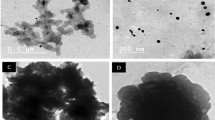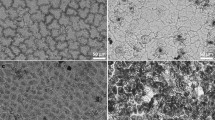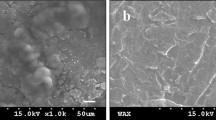Abstract
When NAA is used for fruit thinning, results can be unpredictable. Problemswith foliar penetration of NAA can contribute to this variability. Usingisolated pear leaf cuticles we have investigated effects of humidity,temperature, hard water and selected adjvants on rates of cuticularpenetration of NAA. If NAA was dissolved in deionised water about 40% ofthe applied dose penetrated in 8 h, while water having a pH > 7 practicallyeliminated cuticular penetration of NAA, even at high humidity (100%) andmoderate temperatures (20°C). Rates of penetration were much lowerat 10°C and 55% humidity. Adding urea, ammonium sulphate or Tween20 increased rates of penetration but not to a great extent. Highest rates ofpenetration were obtained when solutions were buffered at pH 4 with DL-lactic acid and the accelerator adjuvant Genapol C-100 was added. Withthis combination, about 70% of the applied NAA dose penetrated within 8 hat 20°C and 40% at 10°C, respectively, even at low humidity(55 to 60%) and when hard water was used as carrier. It is argued thatpoor performance of NAA as chemical thinner must be expected when hardwater is used for spraying and when the pH of the spray liquid is notadjusted to values around 4, such that a significant proportion of the NAAis non-ionised. Only non-ionised NAA can penetrate cuticles. Rates of foliarpenetration of NAA can be greatly increased, especially at low temperatures,by adding 0.2 to 2.0 g l−1 Genapol C-100. Since NAA is destroyed byUV light, spraying should be done in the evening. High humidity during thenight is favourable for foliar penetration, but low temperatures aredetrimental and addition of an accelerator adjuvant (i.e. Genapol C-100) isnecessary. If NAA must be sprayed during cold weather (5–10°C),higher NAA concentrations may be used because rates of penetrationduring the night are proportional to dose and excess NAA left on the foliagewill be destroyed by UV light after sunrise.
Similar content being viewed by others
References
Bauer H and Schönherr J (1992) Determination of mobilities of organic compounds in plant cuticles and correlation with molar volumes. Pestic Sci 35: 1-11
Baur P (1997) Lognormal distribution of water permeability and organic solute mobility in plant cuticles. Plant Cell Environ 20: 167-177
Baur P, Buchholz A and Schönherr J (1997) Diffusion in plant cuticles as affected by temperature and size of organic solutes: Similarity and diversity among species. Plant Cell Environ 20: 982-994
Baur P, Grayson BT and Schönherr J (1996a) Concentration dependent mobility of chlorfenvinphos in isolated plant cuticles. Pestic Sci 47: 171-180
Baur P, Grayson BT and Schönherr J (1997) Polydisperse ethoxylated fatty alcohol surfactants as accelerators of cuticular penetration. 1. Effects of ethoxy chain length and the size of the penetrants. Pestic Sci 51: 131-152
Baur P, Marzouk H, Schönherr J and Bauer H (1996) Mobilities of organic compounds in plant cuticles as affected by structure and molar volumes of chemicals and plant species. Plant 199: 404-412
Baur P, Marzouk H, Schönherr J and Grayson BT (1997) Partition coefficients between plant cuticle and adjuvants as related to foliar uptake. J Agric Food Chem 45: 3659-3665
Baur P and Schönherr J (1995) Temperature dependence of the diffusion of organic compounds across plant cuticles. Chemosphere 30: 1331-1340
Baur P and Schönherr J (1996) Die Aufnahme systemischer Wirkstoffe über Blätter: Grundlagen und Optimierung. Gartenbauwissenschaften 61: 101-115
Baur P and Schönherr J (1997) Penetration of an ethoxylated fatty alcohol surfactant across leaf cuticles as affected by concentration, additives, and humidity. Z. PflKrankh. PflSchutz. 104: 380-393
Black BL, Bukovac MJ and Hull J (1995) Effect of spray volume and time of NAA application on fruit size and cropping of Redchief ‘Delicious’ apple. Sci Hort 64: 313-294
Bound SA, Jones KM and Oakford ML (1997) Integrating Cytolin into a chemical thinning program for red ‘Delicious’ apple. Aust J Exp Agric 37: 113-118
Bukovac MJ and Petracek PD (1993) Characterizing pesticide and surfactant penetration with isolated cuticles. Pestic Sci 37: 179-194
Clever M(1996) Ausdünnungsbehandlungen, beurteilt anhand der Wirtschaftlichkeit und der Wirkung auf die Alternanz. Mitt. OVR des Alten Landes 51: 137-155
Crank J and Park GS (1968) Diffusion in Polymers. London: Academic Press
Cussler EL (1984) Diffusion. Mass Transfer in Fluid Systems. Cambridge: Cambridge Univ. Press
Dietz KJ (1997) Functions and responses of the leaf apoplast under stress. Prog Bot 58: 303-313
Edgerton LJ and Haeseler CW (1959) Some factors influencing the absorption of naphthaleneacetic acid and naphthaleneacetamide by apple leaves. Proc Am Soc Hort Sci 74: 54-60
Elfving DC and Cline RA (1993) Benzyladenine and other chemicals for thinning ‘Empire’ apple trees. J Am Hort Sci 118: 539-598
Graf H (1996) Ausdünnungsempfehlungen für 1996. Mitt. OVR des Alten Landes 51: 156-160
Falk RH (1994) Influence of formulation and adjuvants on foliar location and physical form of the active ingredient. In: Holloway PJ, Rees RT and Stock D (eds) Interactions between adjuvants, agrochemicals and target organisms Springer Verlag Berlin, pp. 53-82
Falk RH, Guggenheim R, and Schulke G (1994) Surfactant induced phytotoxicity. Weed Technol 8: 519-531
Greene DW and Bukovac MJ (1972) Penetration of naphthaleneacetic acid into pear (Pyrus communis L.) leaves. Plant Cell Physiol 13: 329-330
Handschack M (1995) Ausdünnung bei Birnen. Rhein. Monatsschrift 3: 140-141
Hartley GS and Graham-Bryce IJ (1980) Physical principles of pesticide behaviour. London, New York: Academic Press
Jones KM, Bound SA, and Oakford MJ (1994) Combining ethephon and naphthalene acetic acid in one spray to thin ‘Golden Delicious’ apples. NZ J Crop Hort Sci 30: 203-207
Jones KM, Bound SA, Summers CR and Oakford MJ (1997) Preliminary examination of thinning strategies on young ‘Jonagold’ and ‘Pink Lady’ apples. Aust J Exp Agric 37: 377-382
Kerler F, Riederer M and Schönherr J (1984) Non-electrolyte permeability of plant cuticles: A critical evaluation of experimental methods. Physiol Plant 62: 599-606
Kerler F and Schönherr J (1988) Permeation of lipophilic chemicals across plant cuticles: Prediction from partition coef-ficients and molar volumes. Arch Environ Contam Toxicol 17: 7-12
Kirsch T, Kaffarnik F, Riederer M, and Schreiber L (1997) Cuticular permeability of the three tree species Prunus laurocerasus L. Ginkgo biloba L. and Juglans regia L.: Comparative investigation of the transport properties of intact leaves, isolated cuticles and reconstituted cuticular waxes. J Exp Bot 48: 1035-1045
Knoche M and Bukovac MJ (1993) Studies on octylphenoxy surfactants: XI. Effect on NAA diffusion through the isolated tomato fruit cuticular membrane. Pestic Sci 38: 291-297
Link H (1988) Zur Strategies des Ausdünnens. Obst und Garten 5: 302-303
Lownds NK, Leon JM and Bukovac MJ (1987) Effect of surfactants on foliar penetration of NAA and NAA-induced ethylene evolution in cowpea. J Am Soc Hort Sci 112: 554-560
Luckwill LC and Lloyd-Jones CP (1962) The absorption, translocation and metabolism of 1-naphthaleneacetic acid applied to apple leaves. J Hort Sci 37: 190-206
Marzouk H, Baur P and Schönherr J (1998) Relative solubilities of bifenox and naphthylacetic acid (NAA) in plant cuticles and in selected pure or aqueous glycol adjuvants. Pestic Sci 53: 278-284
McWhorter CG (1982) The use of adjuvants. In: Hodgson RH (ed) Adjuvants for Herbicides. Weed Sci Soc of America. USA: Champaign Ill, pp. 10-31
Norris RF and Bukovac MJ (1969) Some physical-kinetic considerations in penetration of nephthalene acetic acid through isolated pear leaf cuticle. Physiol Plant 30: 701-712
Oakford MJ, Bound SA, Jones KM and O'Rielly RG (1995) Use of airshear technology to reduce chemical spray rates for thinning of apples. Aust J Exp Agric 35: 789-794
Ribnicky DM, Ilic N, Cohen JD and Cooke TJ (1996) The effect of exogenous auxins on endogenous indole-3-acetic acid metabolism. Plant Physiol 112: 549-558
Biederer M, Burghardt M, Mayer S, Obermeier H and Schönherr J (1995) Sorption of monodisperse alcohol ethoxylates and their effects on the mobility of 2,4-D in isolated plant cuticles. J Agric Food Chem 43: 1067-1075
Riederer M and Schreiber L (1995) Waxes: The transport barriers of plant cuticles. In: Hamilton RD (ed) Waxes: Chemistry, Molecular Biology and Functions) The Oily Press, Dundee, Scotland, pp 131-156
Schönherr J (1976) Naphthaleneacetic acid permeability of Citrus leaf cuticle. Biochem Physiol Pfl 170: 309-319
Schönherr J (1993) Effects of monodisperse alcoholethoxylates on mobility of 2,4-D in isolated cuticles. Pestic Sci 38: 155-164
Schönherr J (1993) Effects of alcohols, glycols and monodisperse ethoxylated alcohols on mobility of 2,4-D in isolated plant cuticles. Pestic Sci 39: 293-303
Schönherr J and Bauer H (1992) Analysis of effects of surfactants on permeability of plant cuticles. In: Foy CL (ed) Adjuvants and Agrichemicals Vol. 2 Boca Raton, Forida, USA: CRC Press, pp 17-35
Schönherr J and Baur P (1994) Modelling penetration of plant cuticles by crop protection agents and effects of adjuvants on their rates of penetration. Pestic Sci 42: 185-208
Schönherr J and Baur P (1996) Effects of temperature, surfactants and other adjuvants on foliar uptake. In: Kerstiens G (ed) The plant cuticle-an integrated functional approach. Oxford: BIOS Scientific Publ. pp. 134-154
Schönherr J and Bukovac MJ (1972) Penetration of stomata by liquids. Dependence on surface tension, wettability and stomatal morphology. Plant Physiol 49: 813-819
Schönherr J and Bukovac MJ (1978) Foliar penetration of succinic acid-2,2-dimethyl hydrazide: Mechanism and rate limiting step. Physiol Plant 42: 303-311
Schönherr J and Riederer M (1986) Plant cuticles sorb lipophilic compounds during enzymatic isolation. Plant Cell Environ 9: 459-466
Schönherr J and Riederer M (1989) Foliar penetration and accumulation of organic chemicals in plant cuticles. Rev Environ Contamin Toxicol 108: 1-70
Schreiber L (1995) A mechanistic approach towards surfactant/wax interactions: Effects of octaethyleneglycolmonododecylether on sorption and diffusion of organic chemicals in reconstituted cuticular wax of barley leaves. Pestic Sci 45: 1-11
Shafer WE and Bukovac MJ (1988) Studies on octylphenoxy surfactants. Effects of concentration and mixtures on 2-(1-naphthyl)acetic acid sorption in tomato fruit cuticles. In: Cross B and Scher HB (eds) Pesticide Formulations-Innovations and Developments, ACS Symposium Series 371, Washington DC: American Chemical Society, pp. 34-43
Westwood MN and Batjer LP (1960) Effects of environment and chemical additives on absorption of naphthaleneacetic acid by apple leaves. Proc Amer Soc Hort Sci 76: 16-29
Author information
Authors and Affiliations
Rights and permissions
About this article
Cite this article
Schönherr, J., Baur, P. & Uhlig, B. Rates of cuticular penetration of 1-naphthylacetic acid (NAA) as affected by adjuvants, temperature, humidity and water quality. Plant Growth Regulation 31, 61–74 (2000). https://doi.org/10.1023/A:1006354732358
Issue Date:
DOI: https://doi.org/10.1023/A:1006354732358




